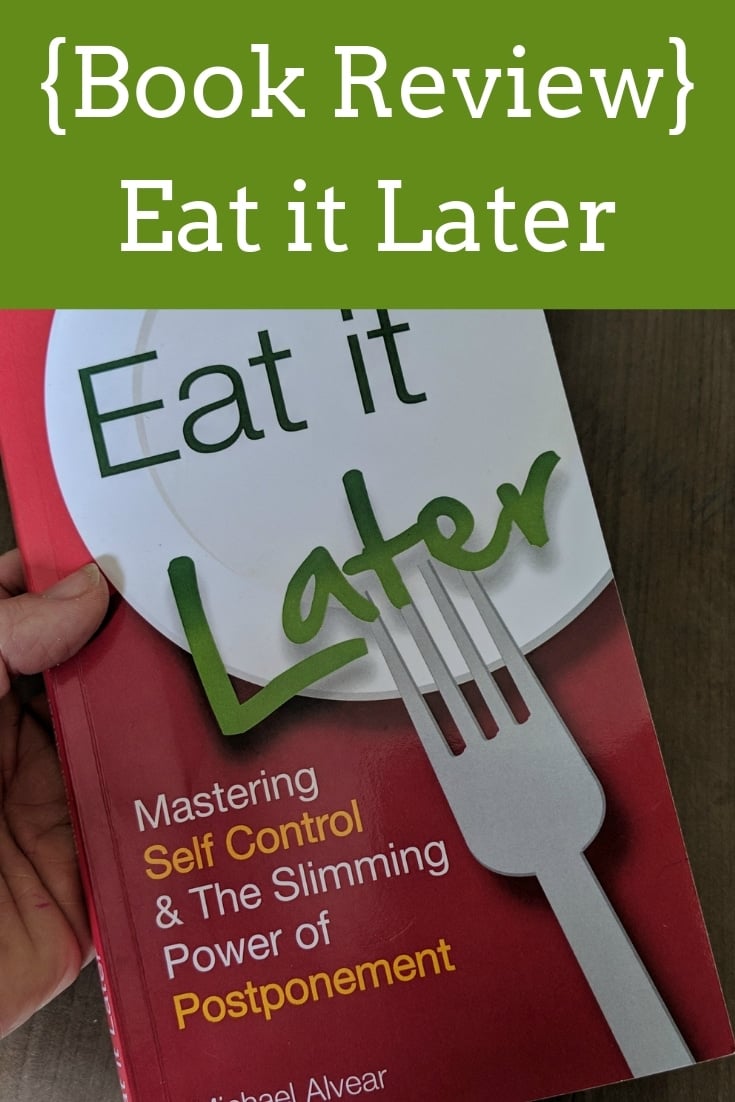Eat it Later {Book Review}
Eat it Later is a short book, about delaying food gratification and mastering self control. It Surprisingly, it had a big impact on me!
I am a skeptic when it comes to weight loss advice. I’ve read a lot of books, and have tried a lot of strategies to eat healthy food, but nothing has truly been a game changer .
That’s why it came as a huge surprise to me when I loved the book, Eat it Later by Michael Alvear. The subtitle is “Mastering Self Control and the slimming power of postponement.”

Want to save this post?
Enter your email below and get it sent straight to your inbox.
Timing is everything on my interest in health topics, and right now I have been thinking a lot about why we give into impulsive cravings.
Impulse control in weight loss
Impulse control seems to be deteriorating, especially in kids. However, it’s more important than it ever was.
A look at the classic Marshmallow experiment shows us that self control is one of the most important characteristics of successful living. In business, in health, and in life, those people who don’t react impulsively and has the ability to wait for something better, will see more success. The author states
“The ability to delay immediate gratification for a better consequence in the future is strongly associated with success later in life”.
Eat it Later, by Michael Alvear
High delay children went on to lead more constructive lives than the kids who wanted the immediate marshmallow. They achieved more in their careers, they coped better with stress and they were thinner.
Can you learn or practice the postponement or delay of pleasure? This book thinks you can, so here were my three takeaways.
Summary of the weight loss advice in the book:
1) Get rid of the weight loss deadlines
The author may not have said this exactly, but he did spend a lot of time talking about how delaying indulgences is a lifestyle to continually practice for the rest of your life.
Stop thinking about dieting as a temporary fix, or a short term event. While this is nothing new, he framed it differently enough for me that I appreciated it more this time. He gives you warning that changing your behavior to delay an impulse is going to take months or years to get good at, so don’t worry if you cave here and there.
It’s a long term solution, and that’s a good thing. The longer you practice this as a lifestyle habit, the better success you’ll see, and the less deprived you’ll feel.
2) Postponing the Goods
I love this idea, and I’ve already practiced it this weekend. Postponing the goods is to feel the impulse or the craving. Recognize it. Identify how strong the craving is. Then decide if it’s high enough to indulge right away, or if it’s possible to wait.
A lot of times we eat as soon as the faintest sign of hunger hits. It’s OK to wait. The longer you can wait, the better your food will taste anyway. It stops you from impulsively grabbing a handful of pretzels, just because.
So, this weekend, I had purchased a cookie from a bakery. Normally, I’d eat it right away. But I intentionally wanted to practice postponing the goods. I didn’t need to eat it as soon as I got it home. I wasn’t that hungry, and I wanted to see if I could postpone it till the evening. I held onto that cookie for almost 6 hours. Then, I carefully and with true mindfulness and intent, ate 1/4 of it, and shared the rest with my kids. I really was more satisfied with 1/4 of the cookie, than if I had swallowed the entire cookie on the way home from the bakery.
3) Bargaining for something better
The final big takeaway for me was the bargaining for something better. When faced with low quality food, is it even worth it to indulge? Would you rather have some cheap imitation chocolate chips, or wait for some creamy European chocolate? Postpone the craving and impulse, knowing that if you do, you could get something better. This not only leaves you feeling satisfied, but also not deprived at all.
The book, Eat it Later, is a quick, 1-2 day read. While nothing is ground breaking, I appreciate the way the author frames the problem of impulse control with some practical strategies to use it to delay eating so much food.
READ NEXT –> 40 Printable Prompts for your food journal




